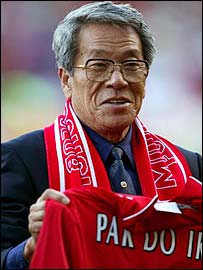Washington Post
Steven Goff
9/11/2007
CHENGDU, China, Sept. 11 — North Korea wrested a tie from the heavily favored United States women’s soccer team in the opening round of the World Cup Tuesday night, scoring two goals within four minutes after an injury to a star U.S. forward left the Americans with just 10 players on the field.
U.S. Coach Greg Ryan elected to play shorthanded in anticipation of star striker Abby Wambach returning later in the game. Wambach did return, but only after the Americans lost their one-goal lead and fell behind, 2-1.
In the 69th minute, Heather O’Reilly ripped a perfectly placed shot to the upper corner to salvage a 2-2 tie before 35,100 spectators on a rainy night at Chengdu Sports Center Stadium.
The U.S. team — which has never finished worse than third in four previous World Cups — will face 2003 runner-up Sweden here Friday and play African champion Nigeria next Tuesday in its Group B finale. The top two finishers in that group will advance to the quarterfinals.
Despite their status as the tournament favorite, the Americans learned very quickly that Tuesday’s match was not going to be easy.
Ryan offered a mild surprise in his starting lineup, moving left back Stephanie Lopez — at age 21,the team’s youngest player — into the midfield and playing with only three defenders. There had been speculation that he might also use two forwards instead of the usual three to offset North Korea’s midfield strengths, but on this night, Ryan stuck with his dangerous trio of Wambach, O’Reilly and Kristine Lilly.
The North Koreans adapted better than the Americans to the wet conditions, using their technical skill to take the early initiative and mount a steady attack. An early shot on goal skipped wide in the opening minute, and a long ball out of the back forced U.S. goalkeeper Hope Solo to come off her line and smother the ball before a Korean forward could make contact.
The Americans then began to find their footing and put pressure on North Korea’s keeper. Lori Chalupny poked an eight-yard attempt wide, O’Reilly created space on the left side of the penalty area and Cat Whitehill pounded three free kicks from distance into the box.
In the 26th minute, Korean midfielder Ri Un Suk nearly broke the scoreless deadlock with a 25-yard shot that streaked fractionally wide of the left post. Thirteen minutes later, Kim Yong Ae, who had replaced the injured Ho Sun Hui midway through the half, sent a glancing header just beyond the left corner.
The best threat, however, belonged to the Americans as Wambach headed Lopez’s corner kick off the crossbar and Lilly’s rebound bid was deflected wide.
Intermission arrived without a goal. But in the second half, the match opened up.
The Americans went ahead in the 50th minute when Lilly supplied a superb pass to Wambach clear on the right side of the box. Wambach’s 14-yard attempt had just enough pace and direction to skip off goalkeeper Jon Myong Hui’s hands and fall into the far corner of the net. It was her 78th goal in 97 international appearances.
After Lilly sent a 20-yard free kick just wide of the left post, the match took a wild and unexpected turn.
Wambach bumped heads with a Korean player and suffered a cut in the back of her head. Wambach had to leave the game with blood pouring from her head. She headed toward the locker room for repairs, and had just passed behind the U.S. bench when the Koreans struck for the 58th-minute equalizer.
Solo was in proper position to handle Kil Son Hui’s rising 22-yard shot, but let the ball slide between her wet gloves and drop into the net.
Things continued to unravel for the Americans when, in the 62nd minute, Kim Yong Ae took advantage of a wayward U.S. clearance and slid a 12-yard shot into the far corner, putting the Koreans ahead and sparking a wild celebration on the field and in the stands.
Wambach returned two minutes later, bringing the U.S. team back to full strength. In the 69th minute, Lilly’s cross was deflected twice to O’Reilly, who stung a 10-yarder into the top far corner.
Solo made amends for her earlier gaffe with a spectacular diving save on a laser shot by Ri Un Gyong. In a pregame news conference, FIFA President Joseph “Sepp” Blatter expressed concern about the lopsided result of Monday’s tournament opener — an 11-0 victory by Germany over Argentina — and the ramifications it might have on the organizing body’s decision on whether to expand the field to 24 teams from 16 in 2011.
“Definitely, I did not like this result,” he said. “This is not good when we look forward to the future to perhaps have 24 teams.”
However, in response to a follow-up question, Blatter added: “It’s only the first match. For us, it will be good if we can open this competition because in 1995 I said the future of football is feminine and it is still feminine.”
FIFA (the International Federation of Association Football) will decide this fall whether to expand the field and also determine the host country for the 2011 tournament. Canada, Germany, Australia and Peru are the top candidates, Blatter said.

 Pak was introduced to modern western audiences through his appearance in the documentary
Pak was introduced to modern western audiences through his appearance in the documentary 






